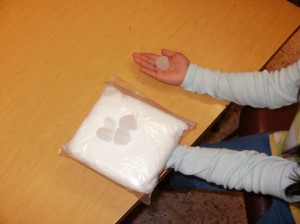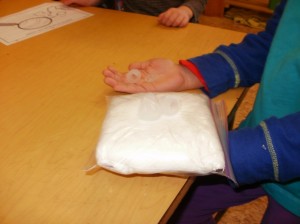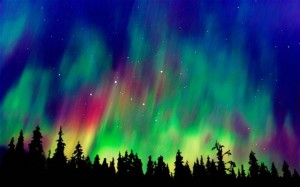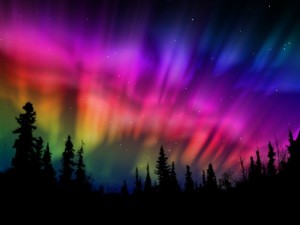For eight months a year, the ice-covered water of Hudson Bay is the polar bear’s home. How does the polar bear survive there for so long?  This drawing of ta polar bear is eight feet tall. Some male polar bears can be ten feet tall when they are standing on their back legs. Division 10 learned that the polar bears have bodies that are suited for living on the ice. Their unique features, or adaptations, help keep them warm. Polar bears have two layers of fur . . . an outer layer that sheds snow, ice and water and a layer of dense fur that keeps heat from escaping. A polar bear also has black skin. The skin helps to attract heat. Under the skin is a thick layer of fat called blubber.
This drawing of ta polar bear is eight feet tall. Some male polar bears can be ten feet tall when they are standing on their back legs. Division 10 learned that the polar bears have bodies that are suited for living on the ice. Their unique features, or adaptations, help keep them warm. Polar bears have two layers of fur . . . an outer layer that sheds snow, ice and water and a layer of dense fur that keeps heat from escaping. A polar bear also has black skin. The skin helps to attract heat. Under the skin is a thick layer of fat called blubber.



- Home
- Reminders
- Log In
Afrikaans
Albanian
Amharic
Arabic
Armenian
Azerbaijani
Basque
Belarusian
Bengali
Bosnian
Bulgarian
Catalan
Cebuano
Chichewa
Chinese (Simplified)
Chinese (Traditional)
Corsican
Croatian
Czech
Danish
Dutch
English
Esperanto
Estonian
Filipino
Finnish
French
Frisian
Galician
Georgian
German
Greek
Gujarati
Haitian Creole
Hausa
Hawaiian
Hebrew
Hindi
Hmong
Hungarian
Icelandic
Igbo
Indonesian
Irish
Italian
Japanese
Javanese
Kannada
Kazakh
Khmer
Korean
Kurdish (Kurmanji)
Kyrgyz
Lao
Latin
Latvian
Lithuanian
Luxembourgish
Macedonian
Malagasy
Malay
Malayalam
Maltese
Maori
Marathi
Mongolian
Myanmar (Burmese)
Nepali
Norwegian
Pashto
Persian
Polish
Portuguese
Punjabi
Romanian
Russian
Samoan
Scottish Gaelic
Serbian
Sesotho
Shona
Sindhi
Sinhala
Slovak
Slovenian
Somali
Spanish
Sudanese
Swahili
Swedish
Tajik
Tamil
Telugu
Thai
Turkish
Ukrainian
Urdu
Uzbek
Vietnamese
Welsh
Xhosa
Yiddish
Yoruba
Zulu



